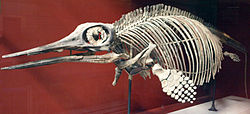Ophthalmosaurinae
| Ophthalmosaurinae Temporal range: Middle Jurassic-Early Cretaceous, 171.6–99.6 Ma |
|
|---|---|
 |
|
| Ophthalmosaurus icenicus skeleton | |
| Scientific classification | |
| Kingdom: | Animalia |
| Phylum: | Chordata |
| Class: | Reptilia |
| Order: | †Ichthyosauria |
| Family: | †Ophthalmosauridae |
| Subfamily: |
†Ophthalmosaurinae Baur, 1887 |
| Genera | |
|
†Acamptonectes |
|
†Acamptonectes
†Cryopterygius
†Janusaurus
†Leninia
†Mollesaurus
†Ophthalmosaurus
†Palvennia
†Undorosaurus
Ophthalmosaurinae is an extinct subfamily of ophthalmosaurid thunnosaur ichthyosaurs from the Middle Jurassic to the late Early Cretaceous (Bajocian - Albian) of Europe, North America and South America. Currently, the oldest and the basalmost known ophthalmosaurine is Mollesaurus from the early Bajocian of Argentina. Ophthalmosaurines were characterized by a large extracondylar area of the basioccipital in form of a thick and concave peripheral band, posterodistally deflected ulnar facet of the humerus, large ulna with concave and edgy posterior surface and ischiopubis with obturator foramen.
...
Wikipedia
